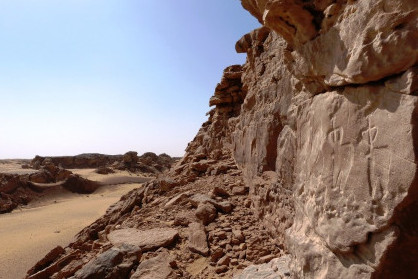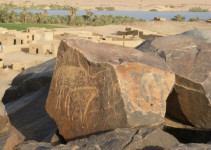Exhibitions
Departments
(A popular science article)
Rock images discovered in the Dakhleh Oasis, dating back to 7 500-6 000 years ago, feature, among others, female figures and giraffes led on ropes. Those depictions, keeping the secrets of life and beliefs of Neolithic communities inhabiting the Oasis, are the subject of investigations carried out by an interdisciplinary team of researchers.
The term rock art is most often associated with paintings known from southern France and Spain - the Paleolithic masterpieces, which at the end of the nineteenth century came to light from the forgotten depths of caves. It is worth noting, however, that the idea of leaving messages on rocky surfaces appeared in many cultures and on all the continents.
Archaeology as a scholarly discipline has long neglected this source of knowledge about the past. Its research methodology had no place for these difficult-to-classify images, the understanding of which would require the combined expertise in archaeology, anthropology and art history. Only at the end of the twentieenth century, along with the changes in research methods and approaches, it began to become clear that this extraordinary phenomenon was a window open towards the past, which anybody had ever been looking through before.
The research on rock art still often leads to blind alleys. Although rock images are almost direct messages, it is important to realise that at the two ends of this "fast-connection" are "computers" with two completely different operating systems - the minds of us, people of the 21st century as receivers, and prehistoric artists as senders. Finding a common language is not easy but worth the efforts. The researchers have long been working on this issue, including Polish scientists who in 1985 started their investigations in the Dakhleh Oasis in the south of Egypt.
The Islands of the blessed
This is how Egyptian oases were called by Herodotus in the 5th century BC. Given that they are located in the most inhospitable region of the world - in the Western Desert – this name is fully justified. These five "islands", the enclaves of water, vegetation and life must have been a real blessing for the travellers that arrived there.
The Dakhleh Oasis (which in Arabic means the internal oasis) is located in the southern part of Egypt, about 600 km in a straight line from Cairo. It does not resemble the picture known from Hollywood movies – like a reservoir with azure water surrounded by date palm trees – but a concentration of small villages and cities, stretching for almost 100 km in length and inhabited by nearly 80 thousand people. The ethnically diverse community of the Oasis, where practically every village has its own dialect best illustrates its complicated and turbulent history. Human groups have settled the Oasis continuously for around 200 000 years, so it is not surprising that it is sometimes called 'eternal'.
Since 1977, the Dakhleh Oasis Project (D.O.P.) has been operating in this region – an international and interdisciplinary research mission led by Professor Anthony Mills. The D.O.P. has been granted the permission to explore the entire Oasis (which hardly happens in Egypt, where concessions for the investigations of specific areas are measured in meters). This made it possible to pursue the main idea of the project – the study of the Dakhleh Oasis as a kind of a separate organism, a microcosm. Its isolation makes it possible to capture factors and stimuli that influenced its development as well as trace the mechanisms of changes and ways of adaptation.
The researchers that have participated in this project, operating under the Canadian auspices, come from Australia, Great Britain, United States, the Netherlands, Osterreich, Germany, and Poland. The team has included geologists, botanists, linguists, architects, physical and cultural anthropologists, historians, and, of course, archaeologists.
Already in the first years of research, during a reconnaissance around the Oasis, numerous rock engravings (petroglyphs) were found. Therefore, in 1985 Professor Lech Krzyżaniak, a specialist in the Saharan rock art from the Archaeological Museum in Poznań, was invited to participate in the project.
Surprisingly, rock art in this region had previously been dealt with by few people. One of them was Hussanein Bey, an Egyptian, traveller and adventurer, a representative of the Egyptian diplomatic service, who in 1923 made an epic camel journey across the Western Desert, covering 3400 km and reaching as far as Darfur in Sudan. Along the way, he came across many sites with rock art, which he later described in his book "The Lost Oasis". Another explorer was the Hungarian Count Ladislaus de Almasy, later accused of spying for the German Reich. In 1933, in the area of Gilf Kebir, he discovered a famous cave with paintings depicting 'swimmers in a prehistoric lake'.
Methodological research of rock art in this region was initiated only by Hans, Winkler, a German art historian, ethnographer, and philologist, who in 1939 published the two-volume, already classic work titled "The Rock Drawings of Southern Upper Egypt". Among the petroglyphs described there were several examples from the area of eastern Dakhleh Oasis.
It took more than forty years for this work to continue. As part of the Dakhleh project, the Petroglyph Unit was established, operating currently as a joint project of the Archaeological Museum in Poznań and the Poznań branch of the Institute of Archaeology and Ethnology, Polish Academy of Science, coordinated by the Centre for Mediterranean Archaeology of the University of Warsaw in Cairo.
Nasza strona internetowa używa plików cookies (tzw. ciasteczka) w celach statystycznych, reklamowych oraz funkcjonalnych. Dzięki nim możemy indywidualnie dostosować stronę do twoich potrzeb. Każdy może zaakceptować pliki cookies albo ma możliwość wyłączenia ich w przeglądarce, dzięki czemu nie będą zbierane żadne informacje. Dowiedz się więcej jak je wyłączyć. OK, Rozumiem



